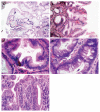Pathophysiological and clinical aspects of gastric hyperplastic polyps
- PMID: 27833379
- PMCID: PMC5083793
- DOI: 10.3748/wjg.v22.i40.8883
Pathophysiological and clinical aspects of gastric hyperplastic polyps
Abstract
Gastric polyps become a major clinical problem because of high prevalence and tendency to malignant transformation of some of them. The development of gastric hyperplastic polyps results from excessive proliferation of foveolar cells accompanied by their increased exfoliation, and they are macroscopically indistinguishable from other polyps with lower or higher malignant potential. Panendoscopy allows detection and differentiation of gastric polyps, usually after obtaining histopathological biopsy specimens. Unremoved gastric hyperplastic polyps may enlarge and sometimes spontaneously undergo a sequential progression to cancer. For this reason, gastric hyperplastic polyps larger than 5 mm in size should be removed in one piece. After excision of polyps with atypical focal lesion, endoscopic surveillance is suggested depending on histopathological diagnosis and possibility of confirming the completeness of endoscopic resection. Because of the risk of cancer development also in gastric mucosa outside the polyp, neighboring fragments of gastric mucosa should undergo microscopic investigations. This procedure allows for identification of patients who can benefit most from oncological endoscopic surveillance. If Helicobacter pylori (H. pylori) infection of the gastric mucosa is confirmed, treatment strategies should include eradication of bacteria, which may prevent progression of intestinal metaplasia. The efficacy of H. pylori eradication should be checked 3-6 mo later.
Keywords: Gastric cancer; Gastric hyperplastic polyp; Pathophysiology; Surveillance.
Conflict of interest statement
Conflict-of-interest statement: There is no conflict of interest among the authors of this study.
Figures


References
-
- Park DY, Lauwers GY. Gastric polyps: classification and management. Arch Pathol Lab Med. 2008;132:633–640. - PubMed
-
- Carmack SW, Genta RM, Schuler CM, Saboorian MH. The current spectrum of gastric polyps: a 1-year national study of over 120,000 patients. Am J Gastroenterol. 2009;104:1524–1532. - PubMed
-
- Cao H, Wang B, Zhang Z, Zhang H, Qu R. Distribution trends of gastric polyps: an endoscopy database analysis of 24 121 northern Chinese patients. J Gastroenterol Hepatol. 2012;27:1175–1180. - PubMed
-
- Archimandritis A, Spiliadis C, Tzivras M, Vamvakousis B, Davaris P, Manika Z, Scandalis N. Gastric epithelial polyps: a retrospective endoscopic study of 12974 symptomatic patients. Ital J Gastroenterol. 1996;28:387–390. - PubMed
Publication types
MeSH terms
LinkOut - more resources
Full Text Sources
Other Literature Sources
Medical

